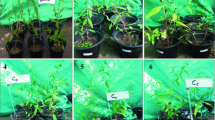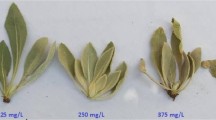Abstract
In the present study, the growth and the Cu2+accumulation by roots, shoots and leaves of Zea mays were examined using copper sulphate in the range of 10−4 to 10−2 M. Plants of Z. mays did not show inhibition of growth in the presence of 10−4 to 10−2 M Cu2+; however, it was observed growth effects on root when different Cu2+ solution concentrations were used. Only the seedlings exposed to 10−2 M exhibited substantial root growth reduction, yielding only 56% of length with respect to the control. Seedlings exposed to 10−4 M Cu2+ exhibited 16% and 42% growth increase in shoots and leaves, respectively, when compared with the controls. The seedlings treated with 10−3 and 10−2 M Cu2+ were inhibited in shoot and leaf growth. The fresh weights in roots, shoots and leaves significantly decreased at 10−2 M Cu2+. The tolerance index, based on root length, was not significantly different for the three different treatments with copper. However, the total accumulation rate was very low at 10−4 and 10−3 M compared to 10−2 Cu treatments. The capacity of copper accumulation by roots, shoots and leaves of Z. mays plants increased concomitant to the copper concentration, arriving to 382 times more in roots, 157 in shoots and only 16 in leaves, all compared to the controls. Cu could be accumulated by roots, shoots and leaves when the initial concentrations were 10−3 and 10−4 M. However, when it was 10−2 M, the metal could not be accumulated by leaf and shoot levels; the roots could increase their copper accumulation capacity three times compared to the control. Z. mays has potential ability to accumulate Cu without being overly sensitive to Cu toxicity.

Similar content being viewed by others
References
Ait Ali, N., Bernal, M. P., & Ater, M. (2002). Tolerance and bioaccumulation of copper in Phragmites australis and Zea mays. Plant and Soil, 239, 103–111.
Brunet, J., Repellin, A., Varrault, G., Terryn, N., & Zuily-Fodil, Y. (2008). Lead accumulation in the roots of grass pea (Lathyrus sativus L.): A novel plant for phytoremediation systems? Comptes Rendus Biologies, 331, 859–864.
Del Rio, M., Font, R., Almela, C., Velez, D., Montoro, R., & De Haro, A. (2002). Heavy metals and arsenic uptake by wild vegetation in the Guadiamar river area after the toxic spill of the Aznalcollar mine. J Biotechnol, 98, 125–137.
Demirevska-Kepova, K., Simova-Stoilova, L., Stoyanova, Z., Holzer, R., & Feller, U. (2004). Biochemical changes in barley plants after excessive supply of copper and manganese. Environ Exp Bot, 52, 253–266.
Ghosh, M. & Spingh, S. P. (2005). A review on phytoremediation of heavy metals and utilization of its by products. Applied Ecology and Environmental Research, 3, 1–18.
Glass, D. J. (2000). Economical potential of phytoremediation. In I. Raskin & B. D. Ensley (Eds.), Phytoremediation of toxic metals: Using plants to clean up the environment (pp. 15–31). New York: Wiley.
Hou, W. Q. (1991). Determination of microelements. In L. Youkai (Ed.), Optimum seeking method for indicating quality of grain corporation (pp. 129–138). Beijing: Agricultural.
Jing, Y., Zhen-Li, H. E., & Yang, X. (2007). Role of soil rhizobacteria in phytoremediation of heavy metal contaminated soils. Journal of Zhejiang University Science B, 8(3), 192–207.
Kabata-Pendias, A. & Pendias, H. (1984). Trace elements in soils and plants. Florida: CRC.
Kabata-Pendias, A. & Pendias, H. (1992). Trace elements in soil and plants. Boca Raton: CRC.
Lasat, H. A. (2002). Phytoextraction of toxic metals: A review of biological mechanisms. Journal of Environmental Quality, 31(1), 109–120.
Liu, D. H., Jiang, W. S., & Hou, W. Q. (2001). Uptake and accumulation of copper by roots and shoots of maize (Zea mays L.). J Environ Sci, 13, 228–232.
Lin, Q., Shen, K. L., Zhao, H. M., & Li, W. H. (2008). Growth response of Zea mays L. in pyrene–copper co-contaminated soil and the fate of pollutants. Journal of Hazardous Materials, 150(3), 515–521.
Luna, C. M., Gonzalez, C. A., & Trippi, V. S. (1994). Oxidative damage caused by an excess of copper in oat leaves. Plant and Cell Physiology, 35, 11–15.
Marschner, H. (1995). Mineral nutrition of higher plants (2nd ed., pp. 333–347). London: Academic.
Meng, Q., Zou, J., Zou, J., Jiang, W., & Liu, D. (2007). Effect of Cu2+ concentration on growth, antioxidant enzyme activity and malondialdehyde content in garlic (Allium sativum l.). Acta Biologica Cracoviensia Series Botanica, 49(1), 95–101.
Mulligan, C. N., Yong, R. N., & Gibbs, B. F. (2001). Remediation technologies for metal-contaminated soils and groundwater: An evaluation. Engineering Geology, 60, 193–207.
Murphy, A. S., Eisinger, W. R., Shaff, J. E., Kochian, L. V., & Taiz, L. (1999). Early copper-induced leakage of K+ from Arabidopsis seedlings is mediated by ion channels and coupled to citrate efflux. Plant Physiology, 121, 1375–1382.
Nielsen, H. D., Brownlee, C., Coelho, S. M., & Brown, M. (2003). Inter-population differences in inherited copper tolerance involve photosynthetic adaptation and exclusion mechanisms in Fucus serratus. New Phytologist, 160, 157–165.
Ouzounidou, G. (1994). Root growth and pigment composition in relationship to element uptake in Silene compacta plants treated with copper. Journal of Plant Nutrition, 17, 933–943.
Ouzounidou, G., Ciamporova, M., & Moustakas, M. (1995). Responses of maize (Zea mays LR) plants to copper stress: IR growth, mineral content and ultrastructure of roots. Environ Exp Bot, 35, 167–176.
Rai, U. N., Tripathi, R. D., Vajpayee, P., Jha, V., & Ali, M. B. (2002). Bioaccumulation of toxic metals (Cr, Cd, Pb, and Cu) by seeds of Euryale ferox Salisb. (Makhana). Chemosphere, 46, 267–272.
Reeves, R. D. & Baker, A. J. M. (2000). Metal accumulating plants. In I. Raskin & B. D. Ensley (Eds.), Phytoremediation of toxic metals: Using plants to clean up the environment (pp. 193–229). New York: Wiley.
Shen, Z. G., Zhang, F. Q., & Zhang, F. S. (1998). Toxicity of copper and zinc in seedings of Mung Bean and inducing accumulation of polyamine. J Plant Nutr, 21(6), 1153–1162.
Shu, W. S., Ye, Z. H., Lan, C. Y., Zhang, Z. Q., & Wong, M. H. (2002). Lead, zinc and copper accumulation and tolerance in populations of Paspalum distichum and Cynodon dactylon. Environmental Pollution, 120, 445–453.
Stephan, U. W. & Prochazka, Z. (1989). Physiological disorders of the nicotianamine-auxotroph tomato mutant chloronerva at different levels of iron nutrition. I. Growth characteristics and physiological abnormalities as related to iron and nicotianamine supply. Acta Botanica Neerlandica, 38, 147–153.
Ucun, H., Aksakal, O., & Yildiz, E. (2009). Copper(II) and zinc(II) biosorption on Pinus sylvestris L. Journal of Hazardous Materials, 161, 1040–1045.
Wang, M., Zou, J., Duan, X., Jiang, W., & Liu, D. (2007). Cadmium accumulation and its effects on metal uptake in maize (Zea mays L.). Bioresource Technology, 98(1), 82–88.
Wei, L., Luo, C., Li, X., & Shen, Z. (2008). Copper accumulation and tolerance in Chrysanthemum coronarium L. and Sorghum sudanense L. Archives of Environmental Contamination and Toxicology, 55, 238–246.
Weng, G., Wu, L., Wang, Z., Luo, Y., & Christie, P. (2005). Copper uptake by four Elsholtzia ecotypes supplied with varying levels of copper in solution culture. Environment International, 31, 880–884.
Acknowledgements
The authors gratefully acknowledge financial support of Facultad de Ciencias de la Salud, Universidad del Norte Santo Tomás de Aquino, Tucumán, Argentina.
Author information
Authors and Affiliations
Corresponding author
Rights and permissions
About this article
Cite this article
Benimeli, C.S., Medina, A., Navarro, C.M. et al. Bioaccumulation of Copper by Zea mays: Impact on Root, Shoot and Leaf Growth. Water Air Soil Pollut 210, 365–370 (2010). https://doi.org/10.1007/s11270-009-0259-6
Received:
Accepted:
Published:
Issue Date:
DOI: https://doi.org/10.1007/s11270-009-0259-6




